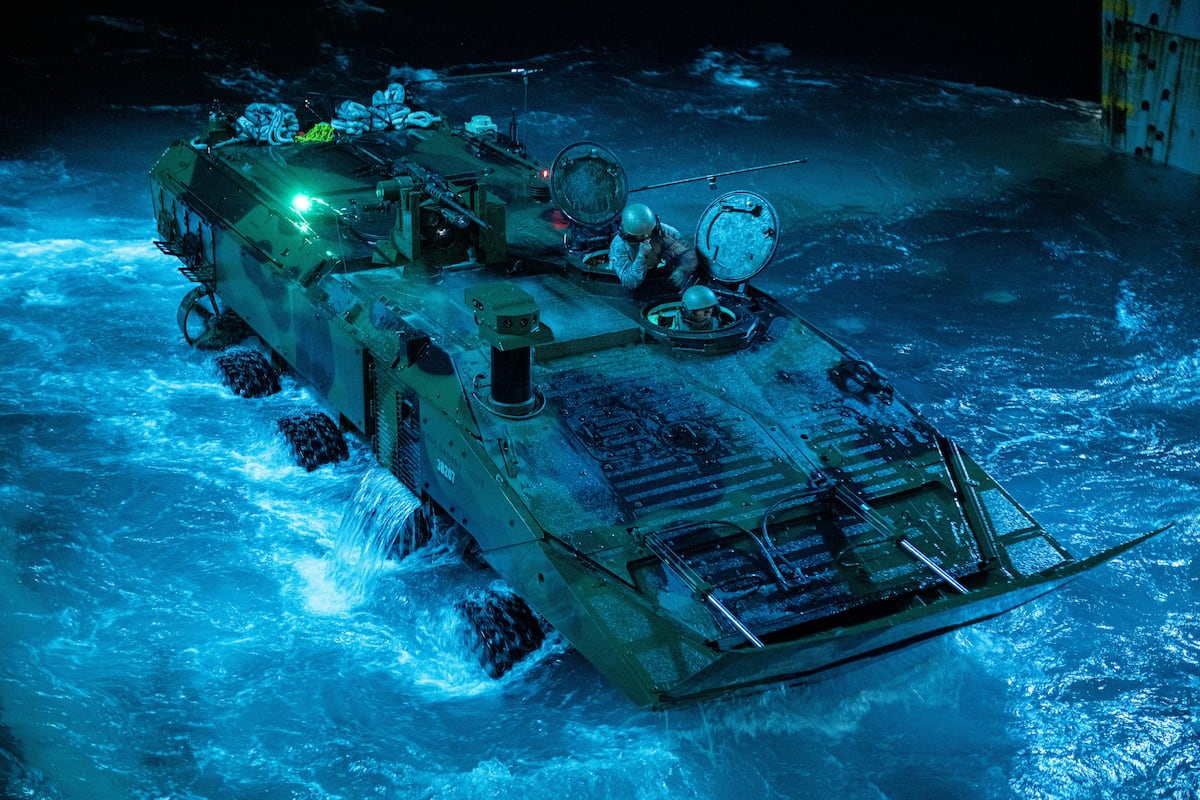Marines put new amphibious vehicle to the test in first at-sea drill

Marines conducted a complex at-sea readiness rehearsal for combat with the service’s new amphibious combat vehicle for the first time while their comrades worked on coastal defense training with partners in the Philippines.
Nearly 200 Marines and 400 sailors from I Marine Expeditionary Force and Expeditionary Strike Group 3 conducted the drills off the coast of Camp Pendleton, California, from Oct. 20 to Nov. 1.
Marines worked through four models of rotary and tiltrotor aircraft in both day and night deck landings aboard the amphibious transport dock Somerset, which concluded a seven-month deployment in August with the 15th Marine Expeditionary Unit.
RELATED
The event, dubbed Quarterly Underway Amphibious Readiness Training, or QUART, ensures that the major components and personnel involved in combined Navy-Marine Corps amphibious operations have worked together and certified their levels of proficiency, according to a Marine release.
“QUART is a vital training opportunity where we can train as a Navy-Marine Corps team to enhance our collective readiness and deterrence capabilities,” said Col. Kevin Hunter, commander of Marine Aircraft Group 16 and QUART 25.1.
The units involved included 3rd Battalion, 1st Marine Regiment; Marine Aircraft Group 16, 3rd Marine Aircraft Wing; and 3rd Assault Amphibian Battalion, 1st Marine Division.
This most recent QUART saw the ACVs embark infantry Marines during both day and night operations.
“This is about being able to deliver combat power ashore,” Navy Capt. Andrew Koy, Somerset commander, said in the release. “This is a rehearsal for the future fight. It’s necessary that we all talk to each other, know what one another is doing, and share a common language.”
The service first put the new ACV, which replaces the decades-old amphibious assault vehicle, to use overseas in May, Marine Corps Times previously reported.
BAE Systems won the contract to produce the new ACV for the Corps in 2018.
The new ACV comes in multiple variants, including a command and control version, a 30mm-cannon-toting version and a recovery variant to haul other ACVs when immobile.
By bringing together the sea, air and land aspects of Marine operations, the QUART exercise puts all those assets under a single colonel’s control, said Col. Jonathan Frerichs, commander of 3rd BN, 1st Marine Regiment.
A main feature of how the Corps is redesigning its structure integrates more heavily with the Navy. At the same time, the restructuring has built units such as the Marine Littoral Regiment, which can be scaled up or down to a fire team or up to an entire regiment.
Putting all those capabilities under the command of a colonel helps provide additional options, firepower and support to a lower-echelon unit that can operate on its own.
Meanwhile, as Marines conducted the QUART off the California coast, 15th MEU Marines were wrapping up training with the Philippine Marines’ 3rd Marine Brigade on the western shores of Palawan, Philippines.
The annual KAMANDAG exercise, which ran from October 15 to 25, included participants from the Royal Thai Marine Corps, Indonesian Marine Corps, the French Armed Forces, Australian Defense Force, British Armed Forces, Japan Ground Self-Defense Force and Republic of Korea Marine Corps, according to a Marine Corps release.
“We’re training to maneuver and mass effects to attrite, block, fix and destroy a force that attempts to land,” said Lt. Col. Nicholas Freeman, commander of Battalion Landing Team 1/5, 15th MEU. “Here, Philippine guides would bring in our forces to rapidly establish an area defense of this landing site. Our engagement area would extend from the beach’s exit routes out to the launch points for enemy landing craft, with a plan for fires integrating both Philippine and U.S. Marine weapons systems.”
That kind of exercise, Freeman said, not only helps the participants find new and effective ways to defend their coastlines but also allows the forces to work together and establish procedures and communications.
“This was part of KAMANDAG, but really it’s part of a larger transformation in the concept and tactics for coastal defense strategy in this region — something that has not been employed or tested at scale for decades in the Indo-Pacific,” said Col. Sean Dynan, commanding officer of the 15th MEU.
Todd South has written about crime, courts, government and the military for multiple publications since 2004 and was named a 2014 Pulitzer finalist for a co-written project on witness intimidation. Todd is a Marine veteran of the Iraq War.







